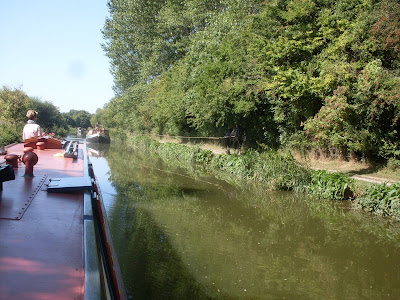That's what we've seen today as we've walked, walked and walked still further in a day long exploration of Bristol.
We started off by intending to tire out seadog Brian with a morning walk up nearby Brandon Hill park so we could leave him in the boat on guard duty for the rest of the morning. I think the walk tired us more than him: the hill is very steep and topped with the Victorian Cabot Tower built in honour of Bristol's famous Elizabethan sailor. You can climb the tower too but a misty morning with no view gave us a good excuse not to!
Next came a stroll across town to the St Nicholas Street market area where we explored a fascinating rabbit warren of indoor and outdoor market stalls trading in every conceivable thing from old stamps to hot sauces to vintage records and ethnic clothing. A pot pourri of tiny, edgy businesses that could never survive in mainstream shopping streets - and maybe a pointer to what some of today's bland city centres could aim for.
On the way back we stumbled upon a streetscape of massive street art works. Truly spectacular pieces of work, many on buildings due for demolition. Bristol - home of Banksy - has a thriving street art scene apparently which even draw its own sizeable tourist traffic.
Next we crossed the harbour yet again on the little 80p ferry for lunch in the famous 'Brunel's Buttery', a little open-air snack bar on the waterfront famed for its bacon sandwiches. It makes 70,000 of them a year.
Naturally I had to sample one (with chips). It was every bit as good as promised. - thick white bread and lashings of bacon. Sensible Mrs B had a jacket potato, also good she says. Though not as good as mine I'm sure! Our old mate Ray from Streethay Wharf dropped by unexpectedly to join our gourmet lunch party on his way home to Cornwall.
 |
| The replica of John Cabot's Elizabethan ship sails past the Great Britain |
And after the Buttery, the ship. Brunel's SS Great Britain exhibition is riveting on every level. The ship itself - the largest in the world when launched in 1845, pioneering iron hull construction and propeller drive on a ship this size, and staying in use until 1933 (albeit with several major refits and a fair share of disasters along the way).
 |
| Brunel's revolutionary propeller |
Then there was the rescue in 1970 which involved refloating the hulk from its resting place in the Falkland Islands where it had been scuttled 40 years earlier and towing it on a pontoon 8000 miles back to the UK.
 |
| The iron hull being conserved in the dry dock 'under water' |
 |
| A recreated cabin |
And finally the conservation and restoration work which has created a magnificent display back in the Bristol drydock in which it was built over 150 years ago. To say too much about what has been done would spoil your visit if you've never been.
Above the water line, you see the ship recreated as it was while below water is the hull as it was rescued being conserved. All I can say is, go and see it. It is magnificent.
Unfortunately the same cannot be said of the 'M Shed' along the harbourside, described as a museum of Bristol, but which is a ragbag of haphazardly arranged bits and pieces that never seems to spend more than a few moments on any subject and offers only superficiality. We were through it in half an hour.
 |
| A shallow stream now but the lock gates show how high the tides can be |
To end the day we walked along the harbourside to the huge lock gates that stem the tidal river - though when we saw it at low tide, there was little more than a stream in a muddy trough. From here you get a fine view of that other famous Brunel enterprise, the Clifton Suspension Bridge, way up high across the Avon Gorge.
It's been a great day in what has proved to be a great city.



















































